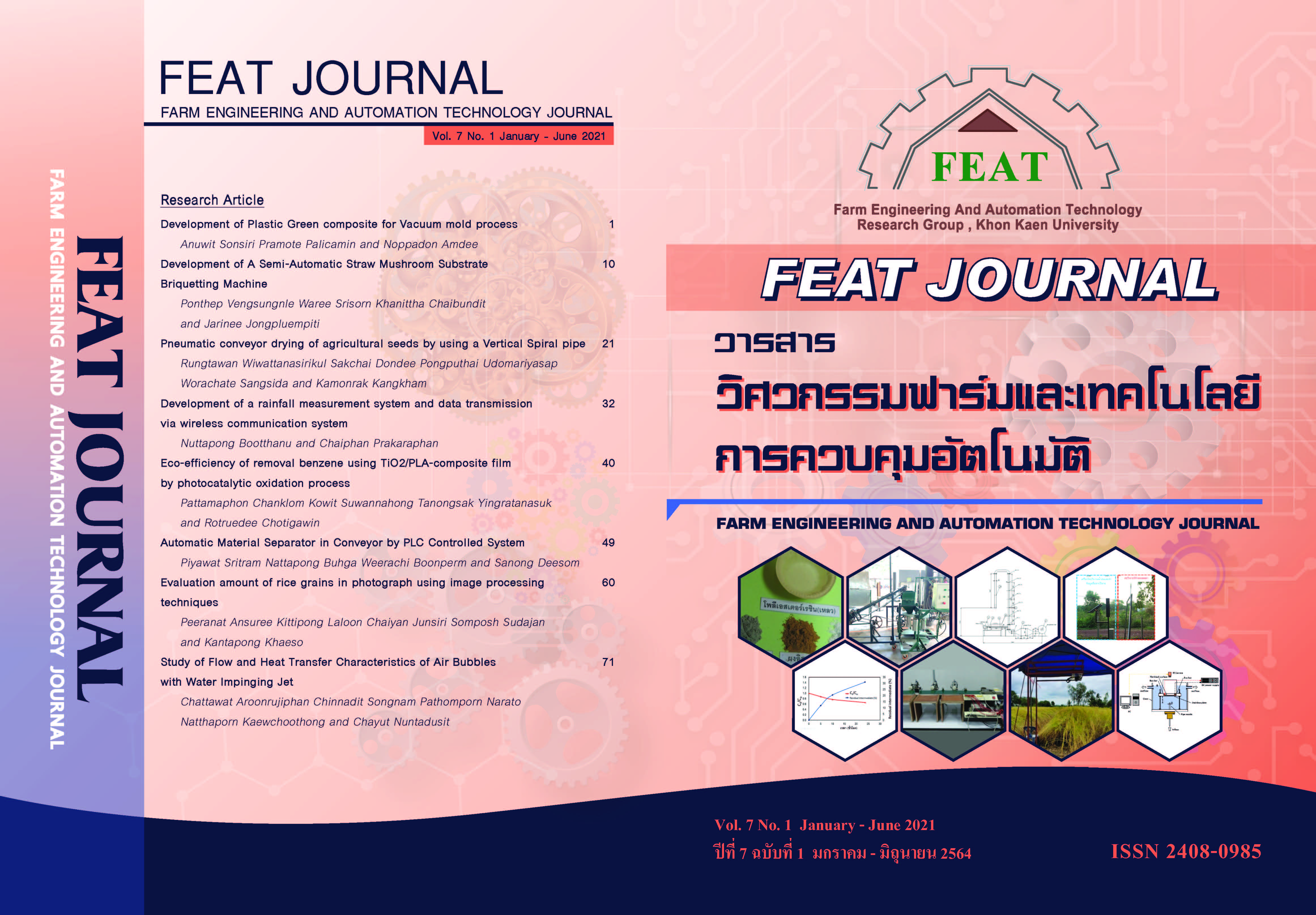Evaluation amount of rice grains in photograph using image processing techniques
Main Article Content
Abstract
Threshing the rice from using combine harvesters has direct impacts variously on the rice yield. The problem caused from the machine itself does not a real matter since the users can manage the machine independently. However, the great unmanageable problem to be primarily considered is the condition of rice in the field such as its growing intensity. Due to the partially inconsistent number of the rice growing in a field, a steady speed of reel index of the combine harvesters will damage the grain in a particular part of the rice field. In the study, the researcher introduces rice grain intensity estimating method by using rice grain screening algorithm system by capturing a digital picture through a camera attached at the top of the combine harvesters in order to further develop the rice combine harvester header with a real-time reel index speed adjusting system. Grains, leaves, stalks and soil surface condition are captured and analyzed concerning the rice moisture content and the altitude at which the picture is captured in real time. The developed rice grain screening algorithm system uses model random forest classification to estimate the rice grain quantity by indicating different color of each part of the rice. During the test, the analyzed result from using rice grain screening algorithm system precisely classified each part of the rice between 59.43 to 86.94 percent of the entire photo pixels. After the process of analyzing, the analyzed intensity of rice production ranges between 3.08 to 6.92 percent. Then the readers can use the result in this study for citation to develop the rice combine harvester header with a real-time reel index speed adjusting system.
Article Details
วารสารวิศวกรรมฟาร์มและเทคโนโลยีควบคุมอัตโนมัติ (FEAT Journal) มีกําหนดออกเป็นราย 6 เดือน คือ มกราคม - มิถุนายน และกรกฎาคม - ธันวาคม ของทุกปี จัดพิมพ์โดยกลุ่มวิจัยวิศวกรรมฟาร์มและเทคโนโลยีควบคุมอัตโนมัติ คณะวิศวกรรมศาสตร์มหาวิทยาลัยขอนแก่น เพื่อเป็นการส่งเสริมและเผยแพร่ความรู้ ผลงานทางวิชาการ งานวิจัยทางด้านวิศวกรรมศาสตร์และเทคโนโลยีพร้อมทั้งยังจัดส่ง เผยแพร่ตามสถาบันการศึกษาต่างๆ ในประเทศด้วย บทความที่ตีพิมพ์ลงในวารสาร FEAT ทุกบทความนั้นจะต้องผ่านความเห็นชอบจากผู้ทรงคุณวุฒิในสาขาที่เกี่ยวข้องและสงวนสิทธิ์ ตาม พ.ร.บ. ลิขสิทธิ์ พ.ศ. 2535
References
วินิต ชินสุวรรณ, สมชาย ชวนอุดม, วสุ อุดมเพทายกุล, วราจิต พะยอม, ณรงค์ ปัญญา. ความสูญเสียในการเก็บเกี่ยวข้าวหอมมะลิโดยใช้แรงงานคนและใช้เครื่องเกี่ยวนวด. วารสารวิจัย มหาวิทยาลัยขอนแก่น. 2542; 4(2): 4-7.
วินิต ชินสุวรรณ, นิพนธ์ ป้องจันทร์, สมชาย ชวนอุดม, วราจิต พะยอม. ผลของอัตราป้อนและความเร็วลูกนวดที่มีต่อสมรรถนะการนวดของเครื่องเกี่ยวนวดข้าวแบบไหลตามแกน. วารสารสมาคมวิศวกรรมเกษตรแห่งประเทศไทย. 2546; 10(1): 9–14.
ชัยยันต์ จันทร์ศิริ และ วินิต ชินสุวรรณ. ผลของปัจจัยการทำงานของเครื่องเกี่ยวนวดที่มีต่อความสูญเสียจากชุดหัวเกี่ยวเมื่อเก็บเกี่ยวข้าวพันธุ์ชัยนาท 1. การประชุมวิชาการวิทยาการหลังการเก็บเกี่ยวแห่งชาติ ครั้งที่ 5, 28-29 มิถุนายน 2550, กรุงเทพมหานคร; 2550.
ชัยยันต์ จันทร์ศิริ. การทำนายความสูญเสียจากระบบการเกี่ยวของเครื่องเกี่ยวนวดข้าวในประเทศไทย. [วิทยานิพนธ์ปริญญาวิศวกรรมศาสตร์]. ขอนแก่น: มหาวิทยาลัยขอนแก่น 2553.
ชัยยันต์ จันทร์ศิริ. พารามิเตอร์การทำงานของเครื่องเกี่ยวนวดที่มีผลต่อความสูญเสียจากชุดหัวเกี่ยวสำหรับข้าวพันธุ์ ขาวดอกมะลิ 105. วารสารวิจัย มหาวิทยาลัยขอนแก่น. 2551; 13(5): 613-20.
Ribera J, Chen Y, Boomsma C, Delp EJ. Counting plants using deep learning. IEEE Global Conference on Signal and Information Processing. 2017; 1344–8.
Ghosal S, Blystone D, Singh AK, Ganapathysubramanian B, Singh A, Sarkar S. An explainable deep machine vision framework for plant stress phenotyping. Proceedings of the National Academy of Sciences. 2018; 115(18): 4613–8.
Ise T, Minagawa M, Onishi M. Identifying 3 moss species by deep learning, using the “chopped picture” method. Open Journal of Ecology; 2017; 8(3): 166-73.
Sa I, Ge Z, Dayoub F, Upcroft B, Perez T, McCool C. Deepfruits: a fruit detection system using deep neural networks. Sensors. 2016; 16(8): 1222.
Xiong X, Duan L, Liu L, Tu H, Yang P, Wu D, et al. Panicle-seg: a robust image segmentation method for rice panicles in the field based on deep learning and superpixel optimization. Plant Methods. 2017;13(1):104.
ปิยะวัฒน์ ศรีธรรม. แขนกลจับชิ้นงานจากเครื่องคัดแยกวัสดุอัตโนมัติตามสายพาน. วารสารวิศวกรรมฟาร์มและเทคโนโลยีการควบคุมอัตโนมัติ. 2561; 4(1): 19-27.
ธีรวัฒน์ เจเถื่อน, ฉัตริน เรืองจอหอ, มงคล คธาพันธ์, กมลชนน วงศ์สถาน, พยุงศักดิ์ จุลยุเสน. การพัฒนาระบบควบคุมการบังคับเลี้ยวสำหรับรถแทรกเตอร์อัตโนมัติ. วารสารวิศวกรรมฟาร์มและเทคโนโลยีการควบคุมอัตโนมัติ. 2562; 5(1): 1-11.
จาริณี จงปลื้มปิติ, พลเทพ เวงสูงเนิน, สาวิตรี ประภาการ, ณัฐดนย์ พรรณุเจริญวงษ์, พลกฤต ปุ่นนอก. การควบคุมจากค่าปรับตั้งที่ใช้ในการควบคุมสภาวะแวดล้อม แบบอัตโนมัติไร้สายภายในโรงเรือนเปิดดอกเห็ดนางฟ้า. วารสารวิศวกรรมฟาร์มและเทคโนโลยีการควบคุมอัตโนมัติ. 2563; 6(1): 40-9.
Desai, SV, Balasubramanian VN, Fukatsu T., Ninomiya S, Guo W. Automatic estimation of heading date of paddy rice using deep learning. Plant Methods. 2019; 15(1): 76.
Abraham S, Huynh C, Vu H. Classification of Soils into Hydrologic Groups Using Machine Learning. MDPI Data. 2019; 5(1): 2.
Rodriguez-Galiano VF, Ghimireb B, Roganb J, Chica-Olmoa M, Rigol-Sanchez JP. An assessment of the effectiveness of a random forest classifier for land-cover classification. ISPRS Journal of Photogrammetry and Remote Sensing. 2012; 67: 93–104.
Yano IH, Alves JR, Santiago WE, Mederos BJT. Identification of weeds in sugarcane fields through images taken by UAV and Random Forest classifier. ScienceDirect IFAC-PapersOnLine. 2016; 49(16): 415–20.
Raczko E, Zagajewski B. Comparison of support vector machine, random forest and neural network classifiers for tree species classification on airborne hyperspectral APEX images. European Journal of Remote Sensing. 2017; 50(1): 144-54.

